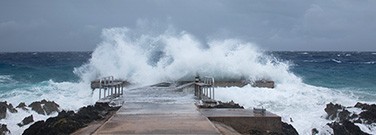New Facility to Recreate the World’s Worst Weather

By Mark Miller
Scientists are planning a first-of-its-kind facility to simulate the conditions of the planet’s most devastating storms and hurricanes. Funded by a $12.8 million grant from the National Science Foundation and led by researchers from Florida International University (FIU), Science News reports that the project will recreate winds of 290 kilometers per hour and storm surges towering six meters high.
Gathering Storms
Driving the project are the effects of climate change. Hurricanes are getting larger, rainier, stronger, and slower, according to Science News. Scientists believe that Atlantic Ocean storm seasons will continue to deliver a higher number of storms and more rapidly intensifying hurricanes have been present in recent seasons.
Research from the new facility will help coastal communities around the world engineer buildings, bridges, roads, and water and energy systems that can withstand this increasingly powerful weather.
Team Effort
The FIU team is working with wind and structural engineers, coastal and ocean engineers, computational modelers, and resilience experts from around the United States to bring the facility to life.
They will also build on existing capabilities. FIU, for example, currently operates the Wall of Wind, a simulator housed in a hangar that generates category five hurricane winds. At Oregon State University, water wave tanks can simulate the gigantic power of tsunamis and storm surges.
One of the aims of the project is to combine these types of simulations into a single entity that can recreate the effects of extreme wind and water together.
Methods and Time
To create a comprehensive picture of nature’s power, the team will combine three proven methods for studying the impact of severe storms: learning from field observations made after a storm, mimicking the behavior of storms by building experimental facilities, and constructing computer simulations to visualize the effects of storms over geographic areas.
Along with meeting a host of other challenges, it will take time to integrate these methodologies. The design phase for the facility is projected to be four years.
At the same time, nature’s clock is ticking. With the accelerating intensity of storms, communities across the globe could be at greater risk with each passing season.
It’s a reality not lost on director of extreme events research at FIU, Richard Olson, PhD. “I don’t think anybody wants to be explaining 20 years from now why we didn’t do this,” he said in the Science News report. “We have challenged nature. Welcome to payback.”
Discussion Questions
- Why are hurricanes so devastating? Use specific attributes to explain.
- How are hurricane categories determined? Provides details about each category.
- Identify three types of weather simulations.